The NVIDIA SHIELD Android TV Review: A Premium 4K Set Top Box
by Ganesh T S on May 28, 2015 3:00 PM EST- Posted in
- Media Streamer
- Home Theater
- TV
- 4K
- Shield
- NVIDIA
Graphics Performance
While the SHIELD Android TV and the underlying Tegra X1 SoC are by no means slouches on the CPU side of matters, ultimately NVIDIA is still just another ARM Cortex implementer. On the other hand when it comes to GPUs, this is where NVIDIA truly shines. As NVIDIA is first and foremost a GPU company, and as a design philosophy always invests more time and die space into GPUs than any other SoC builder (save perhaps Apple X-class SoCs), they have always led the pack on GPU performance. And with the Tegra X1 packing a 256 CUDA core implementation of the very potent Maxwell GPU architecture, an estimated 1GHz clockspeed, and all the power and cooling it needs to keep from throttling, all of the ingredients are in place for a very strong showing from NVIDIA for GPU performance.
If there’s any real downside for NVIDIA and the SHIELD Android TV here, it’s that the Android GPU benchmarking situation hasn’t really caught up with what their GPUs are capable of. The standard benchmarks work, but game benchmarks are virtually non-existent, even in the AA and AAA games NVIDIA has helped bring over to the Android/SHIELD ecosystem. So we can’t for example look at the performance of The Talos Principle in the same way as we can the PC today.
Anyhow, we’ll start off with 3DMark’s Ice Storm Unlimited benchmark.
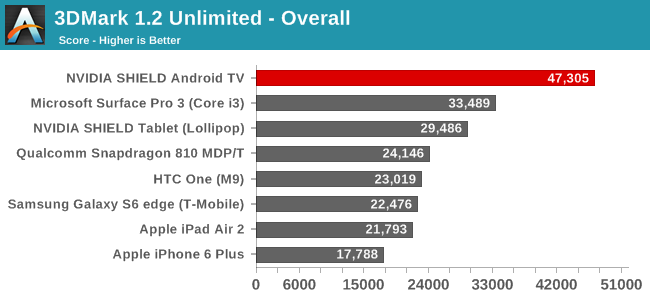
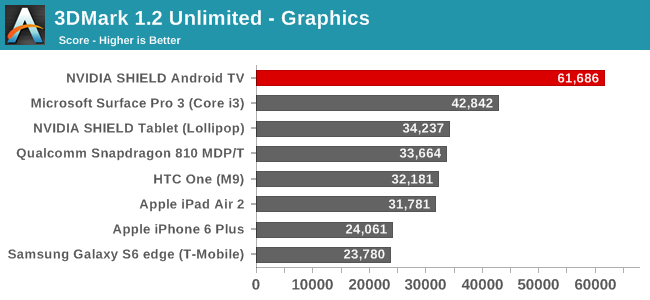
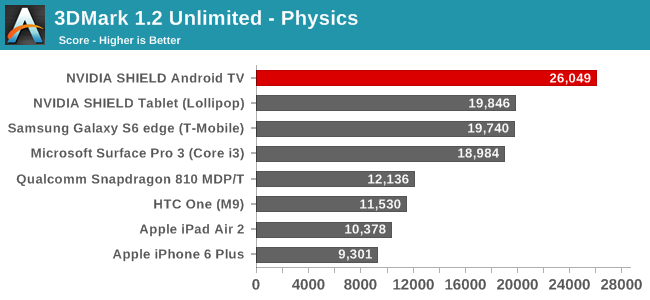
The results here pretty much speak for themselves, especially in the all-GPU graphics sub-score. SHIELD Android TV is 50% faster than the Surface Pro 3 and almost twice as fast as other devices like the iPad Air 2 and the last-generation SHIELD Tablet. Graphics workloads tend to be the most punishing from a heat and power standpoint, and hence are the most likely to get throttled. This really lets the SHIELD and its SoC open up here. At the same time, even in the physics score and the composite overall score, the SHIELD is well in the lead thanks to this combination of factors.
Up next we have BaseMark X 1.1.
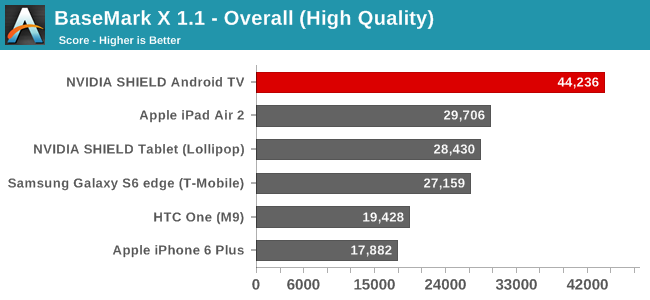
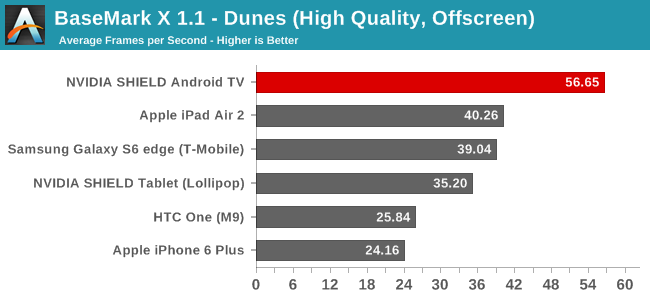

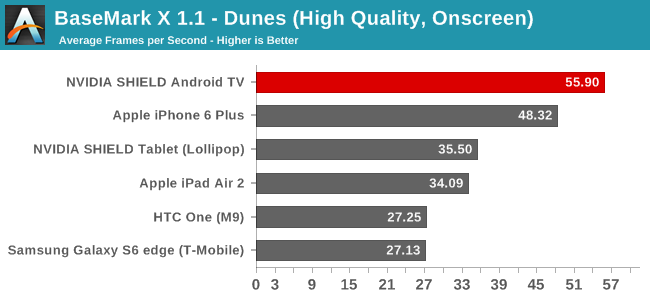
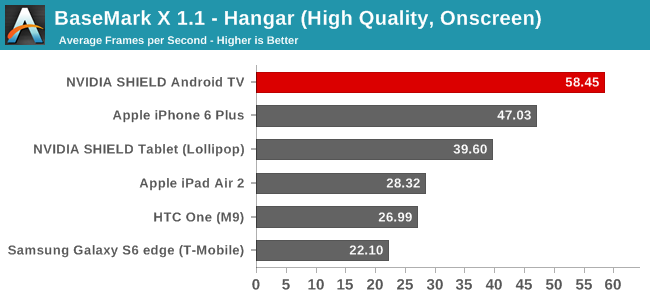
Once more it’s a clean sweep for the SHIELD. Apple’s iPad Air 2 tends to be the second-place finisher, thanks to Apple’s own significant investment in GPU resources, the SHIELD gets yet more resources and the power to fully exploit them. With all of that said, the one thing that does surprise me a bit here is that even the SHIELD can’t crack 60fps on Dunes and Hangar; BaseMark X will likely take one more generation before its tests can be completely beaten.
Our final GPU benchmark is GFXBench.

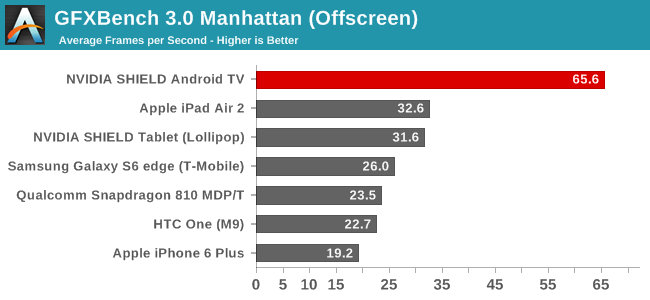
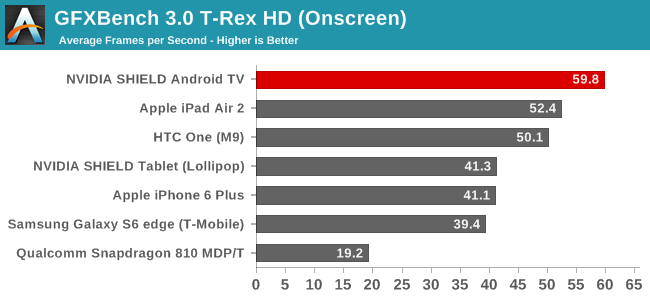
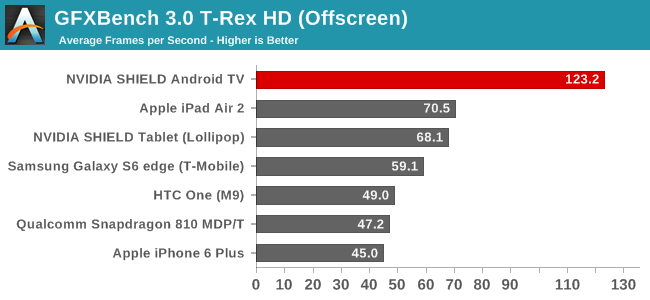
Starting first with the benchmark’s high-level tests, we once again find the SHIELD well in the lead. Of particular note here, the SHIELD Android TV becomes the first Android device to break 60fps on Manhattan, something that as recently as a generation ago seemed impossibly far away.
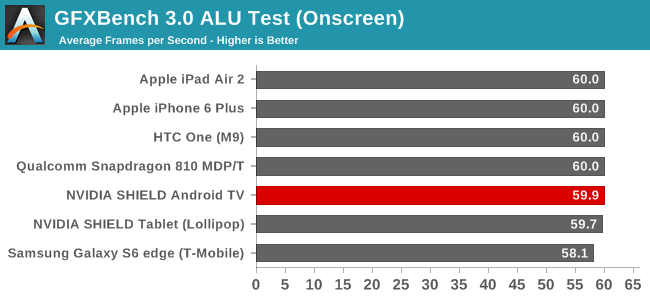
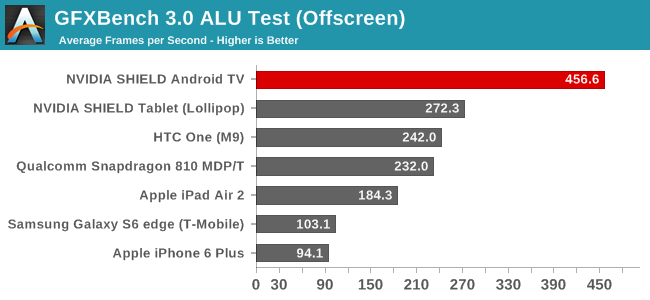

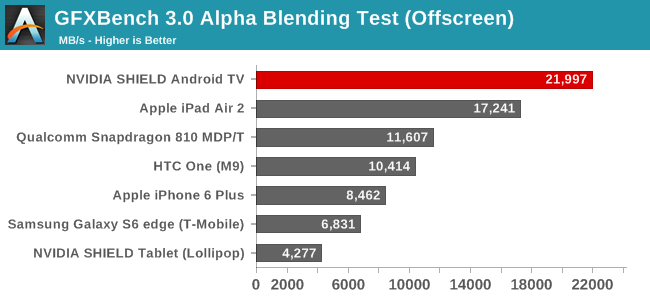
The low-level tests meanwhile offer us an interesting look at SHIELD and Tegra X1 that the high-level tests don’t provide. The ALU test for example drives home the point of just how much in the way of shading resources Tegra X1 has at its disposal (at least when unrestricted), and is a big reason why the SHIELD is doing so well here. On the other hand while NVIDIA still takes the top spot in alpha blending, the lead over the iPad Air 2 isn’t nearly as great, thanks in large part to the iPad’s relatively large 128-bit memory bus. Ultimately SHIELD doesn’t struggle here, but it’s an interesting point of comparison since it shows one of the only cases where SHIELD isn’t a run-away winner, and what kind of graphics workload may eat into its otherwise ridiculous advantage.
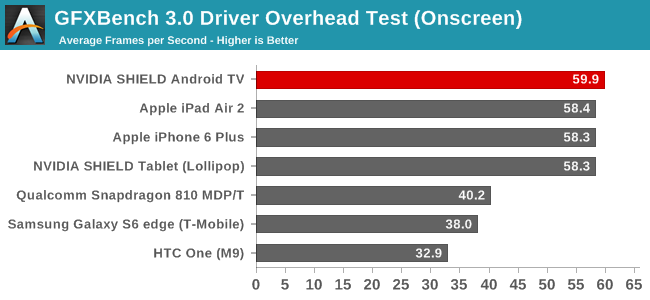
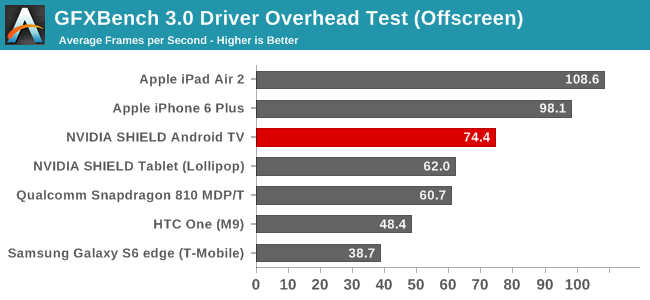
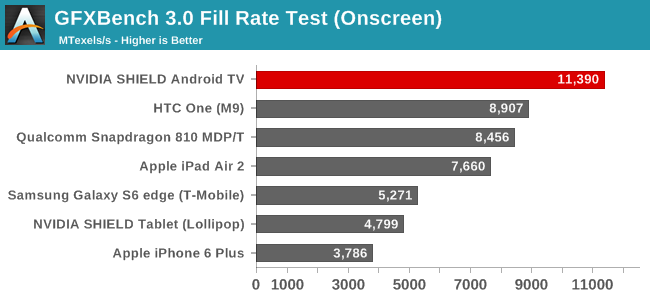
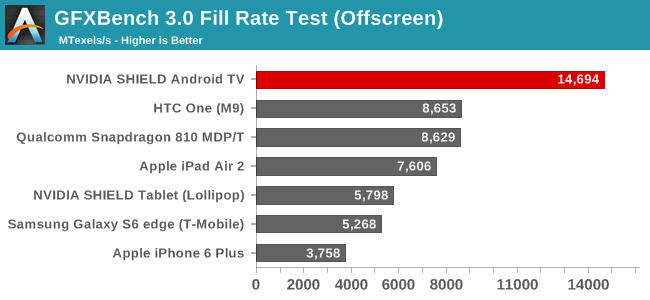
On the last batch of subtests, I’m going to stop again with the fill rate test just to point out another interesting design decision for Tegra X1 and the SHIELD. With NVIDIA banking so much on the set top box’s ability to drive 4Kp60 TVs, NVIDIA needs to push a lot of pixels to get there, as 4K is four-times as many pixels as 1080p. For this reason Tegra X1 is paired with 16 ROPs, giving it low-end PC desktop-like pixel throughput, and of course a huge advantage in the GFXBench fill rate test. And though this fill rate will help with games as well, it’s keeping up with the Android UI at 4Kp60 that is the most important reason for all of this fill rate performance.
Wrapping things up, what else is there to say about the SHIELD Android TV’s GPU performance? What we’re looking at here is twice as fast (or more) than the best phones and tablets today, a combination of the Tegra X1’s very strong GPU design and the set top’s practically unlimited energy and cooling capabilities. Overall NVIDIA is following the path they started long ago on Tegra, always favoring strong GPU performance, leading to the incredible performance we’re seeing here.
With that said, given NVIDIA’s decision to focus on the Android TV aspects of the SHIELD Android TV first and foremost – and not gaming – it’s also fair to say that the SHIELD is overpowered for Android TV work. Other than keeping up with the basic pixel fill needs of 4K, the real power of the box’s GPU is going to be left untapped by Android TV (especially on the ALU side). Which makes all of this humorously absurd in a way, but it’s also why SHIELD Android TV isn’t just an Android TV box. The device’s GPU performance will be put to good use with gaming, though stepping outside the world of benchmarks for a second, the bigger challenge NVIDIA faces is not delivering high performance, it’s delivering games that make full use of that performance.










167 Comments
View All Comments
spinportal - Thursday, May 28, 2015 - link
What is interesting is comparing to the Intel NUCs for a media center hub (or HP Stream Mini) with Windows 10. The CPU power is close to the Intel Celeron 2957U, where a i5-5250U (NUC5i5YH/R) is 50% faster, but the Intel HD graphics is probably 20% slower. Both are fighting for the 4K home theater crowd, but Shield TV is cheaper (barebone NUC is 399 extra SDRAM & mSATA & remote/controller) and baked in 10' UI/UX and easier to maintain for the average user with support for DVR in the future and GRID gaming. Sure Win 10 will have a 10' UI and you can install whatever you want on it to customize to your own content, but higher price to entry and more time needed to tweak. The Intel Stick is cute at $150, but falls short in competition for the checklist of features. If sideloading is easy on the Shield TV, tweakers can rejoice and hope apps will scale properly. If people have an XB1 and enjoy the media apps / services and voice activation, then it's a hard sell. Gamestream is just icing, helping the portability of the Shield TV in a remote location (at home most games would have a big enough screen connected and avoid input lag). It's not a Roku or a Chromecast, so to get customers to make a premium purchase like this, targeting 4K video is the bait.nathanddrews - Thursday, May 28, 2015 - link
"This also means that the SHIELD Android TV will not be doing any HD audio bitstreaming"Stopped reading.
Sivar - Thursday, May 28, 2015 - link
``Consumers need to get their expectations right - the SHIELD Android TV needs consideration only if OTT streaming (4K Netflix, in particular) and gaming credentials are important.''The key feature I need is HEVC compatibility. I have many Blu-rays that I encode with FLAC audio, but with my FireTV, I am unable to use HEVC.
Are you saying that the Shield Android-TV is a poor choice for my requirements?
ganeshts - Thursday, May 28, 2015 - link
If you are savvy enough to encode your Blu-rays with HEVC, then I am sure you understand what I am trying to convey..The typical media library also includes TV programs that are interlaced MPEG-2 (for example). The SHIELD is currently not a good solution for such a case.
I have outlined clearly what works and what doesn't. In your case, I would still suggest waiting for a proper HTPC with HDMI 2.0 / HEVC support unless HEVC-encoded Blu-ray rips are the only media files you plan to play in your setup.
TheJian - Friday, May 29, 2015 - link
Being savvy enough to check a few boxes doesn't mean you know everything about formats. You can muddle through handbrake without doing much more than selecting a profile for your device. The person states they are wanting FLAC+HEVC yet you tell him wait for HTPC. HE was clear in what he needed, so you should just say yes it plays what you need, or no it doesn't instead of a flippant response :( He likely has other players for other formats already hence his main feature desired is what he inquired about.But still you're acting as if mpeg2 interlaced is all anyone wants and a reason to NOT buy it, when I'd suggest it's not many people (that can’t get that some other way until this unit CAN do it, like a dvd player or bluray player in your rack already) and most would want all the other stuff this thing can play NOT just bluray HEVC encoded stuff. IE, anything in mkv/mp4 with dolby etc in h264/x264 (which is most libraries of current content and mostly what people rip bluray to also as you even note in the review). This thing plays a LOT more than hevc. IF you're only going to use the NATIVE Android Tv player then it's somewhat limited, but you're not stuck with that and can choose a dozen or more others (paid or free). 3rd party stuff can easily be had to get around it all if not now then at some point most likely. IE you mention kodi can play mpeg2 without license in software. You also mention Deinterlacing might be added soon to Kodi. So your problem with the device here just a software fix away anyway (and only the interlaced part is a problem correct?)? There are many free apps that can deinterlace already on PC for conversion even if players that do it on android don’t exist…but wait for it…
Just check googleplay store: BSplayer, MX player Pro, KMplayer, vlc, etc (not saying which does the job just noting a bunch):
https://www.youtube.com/watch?v=HSBG13gknoA
1080i mpeg 2 on mxplayer without transcoding. Appears this would solve your combo problem, and this is really old version of the software from 2013 post running on nexus 2013. I’m thinking your excuse for not buying is dead already. You can use de-interlacing option in MX player > settings > decoder. Considering you MENTIONED MX Player in your review, you can’t be this ignorant right or am I missing something? Unlike the OP who may NOT know about all this stuff, you definitely DO know about MX player yet seem to be unable to pass the chance to find some reason to KNOCK an nvidia product even when you know what I just showed fixes it. Typical Anandtech BIAS against Nvidia stuff (**cough AMD portal cough**) here or what?
From your last sentence it almost seems as you're acting like HEVC encoded blurays is all it does, which is categorically false (even though that is what the guy said he wanted to play as a main feature).
Worse you even state most people do the following (which it plays fine):
"The SHIELD Android TV / Kodi combination has absolutely no trouble with the vanilla H.264 files that people usually rip their Blu-rays to."
But no ignore that, it doesn't play mpeg2 interlaced stuff (yet, at least out of the box, but seems to with at least mxplayer as shown which you know about) so it sucks...LOL. OK...Whatever. With 100million-500million installs I think most know about this app (free with ads, $6 without) yet you avoid using it for testing. 2.8million reviews too...LOL. That has to be one of the MOST KNOWN apps on android as most use videos on mobile. How well it works on a TV who knows (10 foot interface? Not sure) but that isn't the point. Worst case you just use it for specific vids with issues. .ts files play fine on mx player also. It seems to have many multiples of the installs of kodi (or xbmc if you like). Kodi on the other hand is only available to the handful of people that can find it (not directly on googleplay so to speak).
http://www.androidpolice.com/2015/04/03/kodi-forme...
You can follow how to get to it above I guess if desired (from googleplay & not sideloaded). Maybe this will help it gain popularity ;)
http://forum.kodi.tv/showthread.php?tid=160720&...
Instructions here too I guess.
MX Player features (among other stuff):
"Plays almost every movie files including .3gp .avi .divx .f4v .flv .mkv .mp4 .mpeg .mov .vob .wmv .webm .xvid and many more."
Either I'm missing something here, or don't really get the complaints you're making nor your flippant response to the OP. Are you saying MX Player with deinterlacing checked won't work for mpeg2 as shown in the supplied youtube video? That guy is testing 1080i mpeg2 on it. I'm confused.
Adding-Color - Thursday, May 28, 2015 - link
My ibothsion is that it will play hevc/h.265 content with hardware acceleration and flac should have no licensing issues and doesn't need hardware acceleration, software acceleration should very well be possible on such a beefy SOC. I don't know if there's yet a software avaible that combines both though.Adding-Color - Thursday, May 28, 2015 - link
My impression ...Aegrum - Thursday, May 28, 2015 - link
Perhaps I missed it, but to me the killer feature is streaming my steam library to my TV from my GTX 680 desktop. Why didn't you cover that? I couldn't care less about the android games. Being able to plop down on my couch and stream Witcher 3 from my PC is worth the price of admission, as it nullifies any desire for a steambox, if it works well.jjj - Thursday, May 28, 2015 - link
The 50$ Sream Link should do that in a few months. If it works well enough , getting this just for that feature is excessive.Aegrum - Friday, May 29, 2015 - link
Sadly that price doesn't include the Steam controller, which is likely to be at least $50. I'm also in need of a streaming device for the television, so while yes, a steam link + controller + chromecast would be ~$135, I think the extra capabilities of this device for $200 is a fair price. Plus it's 4K ready for once I get a 4K TV, and all on one HDMI input that I don't have to switch between. And plays more than just what I have in Steam, though unconfirmed whether Steam link will play non-steam titles or not.I like the Steam link, especially for the price, but for me I think the Shield console is a better fit.